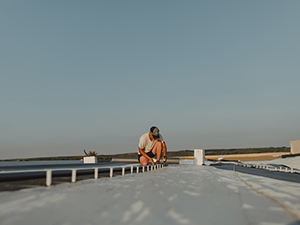
For commercial building owners in Battle Creek, MI, managing a roofing system involves more than fixing leaks when they occur. The key to getting the most value from your roof investment lies in understanding the roof’s life cycle, and planning appropriate commercial roofing services at every stage. A proactive approach minimizes disruption, reduces long-term costs, and maximizes the lifespan of your roof.
If you are unsure where your roof stands in its life cycle or how to plan your next steps, JM Roofing Solutions is here to help. Contact their team at 269-361-8305 to schedule an evaluation to build a maintenance and repair roadmap tailored to your building’s needs in Battle Creek, MI.
Understanding Your Roof’s Life Cycle and Planning Commercial Roofing Services
Just like any asset, your commercial roof has a finite life cycle made up of several phases—each requiring specific services to maintain performance and delay costly replacements.
Installation Phase (0–5 Years)

This is when your roof is in peak condition. Assuming it was properly installed using quality materials, the first few years require minimal intervention. However, this phase is crucial for establishing a baseline inspection and ensuring that warranties are active and all documentation is in place.
Recommended Services:
- Initial inspection documentation
- Warranty validation and record-keeping
- Drainage checks to avoid ponding issues early on
Preventive Maintenance Phase (5–15 Years)
As the roof ages, exposure to UV rays, weather, and foot traffic begins to show. This is the phase where preventive maintenance plays the most important role. Many roof systems that should last 20–30 years fail prematurely because of neglected routine care.
Recommended Services
Biannual inspections in spring and fall, cleaning debris and clearing drains, resealing flashing, and penetration points, and performing minor repairs to seams and fasteners.
Proactive commercial roofing services during this phase can extend your roof’s performance and delay the onset of significant wear.
Repair and Restoration Phase (15–25 Years)
This is when wear and tear become more noticeable. Your roof may begin to experience minor leaks or require flashing repairs and membrane patching. However, a full replacement might not be necessary if restoration is performed on time.
Recommended Services
Targeted repairs of cracked or worn membranes, re-coating metal or flat roofs to restore reflectivity and waterproofing, flashing and edge detail upgrades, and moisture scans to assess hidden water damage. This is a cost-effective window to restore rather than replace, especially if the roofing system is structurally sound.
Replacement Phase (25+ Years or Earlier, if Neglected)
Eventually, even the best-maintained roof reaches the end of its functional life. At this stage, commercial roof replacement becomes necessary—not only to avoid recurring leaks but also to improve energy efficiency and meet updated building codes. Recommended services include a full tear-off or overlay depending on structural conditions, upgrading insulation and drainage systems, and integrating modern roofing materials for enhanced performance and energy savings. Planning for this phase ahead of time allows for proper budgeting and minimizes business disruption during construction.
Roof Lifecycle Planning Matters
Weather conditions in Battle Creek, MI, from heavy snowfall in winter to intense summer UV exposure, can drastically affect the pace of roofing deterioration. By understanding your roof’s current life cycle stage, you can schedule services proactively, avoid unexpected failures, and maximize your return on investment.
For example, roofs exposed to excessive ponding water may deteriorate more quickly and require earlier restoration. Likewise, buildings with high foot traffic or rooftop equipment might see faster membrane wear.
JM Roofing Solutions offers commercial roofing services that are aligned with each life cycle phase, helping building owners in Battle Creek, MI avoid emergency costs and plan with confidence.
Planning Ahead: What Commercial Building Owners Should Do Now
Taking a long-term approach does not mean deferring action. In fact, it means taking strategic steps today to prevent bigger issues tomorrow. Here are practical ways to plan your commercial roofing services:
Create a roof asset management plan: Include inspection dates, warranties, maintenance records, and future service forecasts.
Schedule regular inspections: Do not wait for visible damage. Inspections catch early signs of wear before they escalate.
Budget annually for roofing upkeep: Allocating even a modest budget for maintenance can help you avoid surprise repair bills.
Choose service partners familiar with local conditions: Contractors in Battle Creek, MI understand the unique weather challenges that influence roof lifespans.
Commercial Roofing Services Experts!
Your commercial roof is one of your building’s most valuable assets. Understanding where it stands in its life cycle allows you to plan smart, prevent surprises, and preserve building integrity.
If you are unsure about your roof’s condition or want to develop a tailored service schedule, contact JM Roofing Solutions in Battle Creek, MI at 269-361-8305. Their experienced team provides thorough assessments and life-cycle-aligned commercial roofing services to help you protect your investment with confidence.
FAQ
How often should a commercial roof be inspected?
At minimum, twice per year—typically in the spring and fall. Additional inspections should be done after severe weather events.
What is the typical lifespan of a commercial roof?
Depending on the material, commercial roofs can last 20–40 years. Regular maintenance significantly extends this lifespan.
When should I start planning for roof replacement?
Start planning during the restoration phase (around 15–20 years) or sooner if inspections reveal major structural or membrane damage.
Can I delay replacement if I restore the roof?
Yes, if caught early, restoration can extend a roof’s life by 5–10 years, delaying the need for full replacement.
What are the signs my roof needs more than just maintenance?
Frequent leaks, sagging areas, visible membrane deterioration, and persistent ponding water suggest the need for restoration or replacement.
